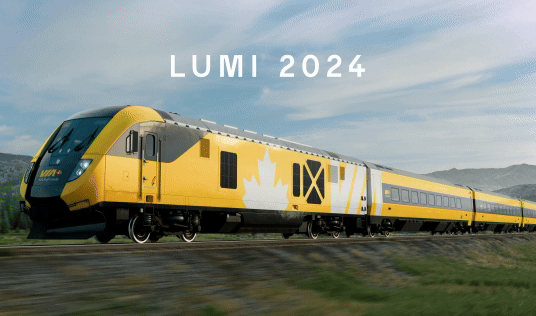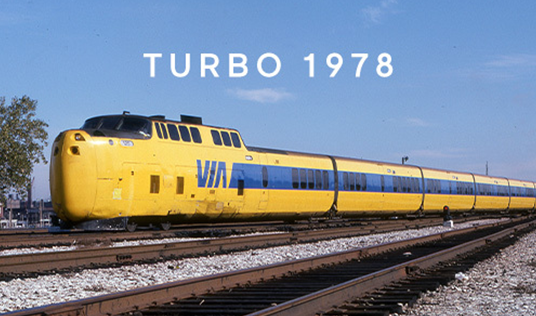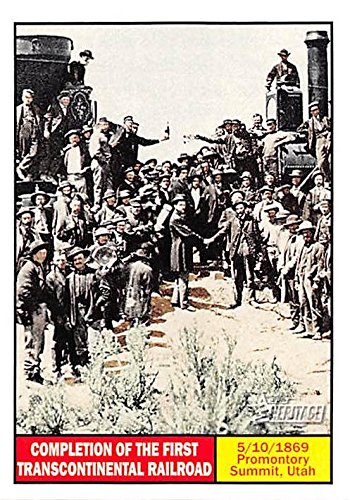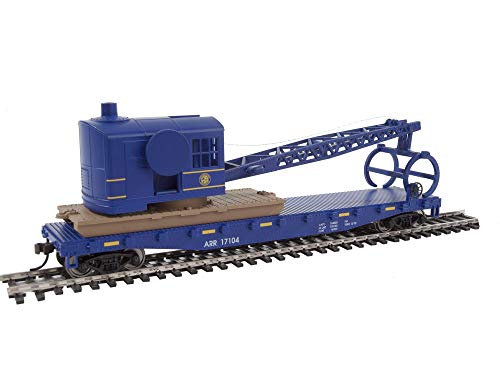Also London:
You are using an out of date browser. It may not display this or other websites correctly.
You should upgrade or use an alternative browser.
You should upgrade or use an alternative browser.
VIA New Corridor Trains - 2021 - 2024 Updates
- Thread starter NS VIA Fan
- Start date

Help Support Amtrak Unlimited Discussion Forum:
This site may earn a commission from merchant affiliate
links, including eBay, Amazon, and others.
Marbleski
Train Attendant
Here is a short clip of one venture train arriving in Ottawa yesterday and another departing. For those interested you should be able to pick out the unit numbers.
CANADA’s Train #35 Arr & #26 Dep Ottawa June 27
CANADA’s Train #35 Arr & #26 Dep Ottawa June 27
From VIA Rail today:
Moderator Note: Fixed formating


Introducing Lumi
To mark the long-awaited arrival of our new fleet, and as a nod to one of VIA Rail’s first trains, we’re launching a special train set with a very unique exterior design. Short for luminosity in English and lumineux in French, Lumi is a one-of-a-kind VIA-yellow train that will be in service at the end of August.
Don’t be surprised if you see a bright yellow train zipping through the landscape, as every single one of our new trains goes through a rigorous series of tests before it can safely welcome travellers.
Moderator Note: Fixed formating
Last edited by a moderator:
Will look forward to trying!
CN is making a similar requirement for elongated consists with VIA's Siemens sets that they made previously with Amtrak. Apparently there are level crossing issues with the lighter trains, with the two suggested solutions being to add cars or operate crossings "manually" until a permanent solution (shunt enhancer) is found.
https://tracksidetreasure.blogspot.com/2024/10/breaking-buffer-cars-20-on-via.html
https://tracksidetreasure.blogspot.com/2024/10/breaking-buffer-cars-20-on-via.html
west point
Engineer
All these signal problems . Why no problems in Europe? Is it something with wheel and rail profiles??CN is making a similar requirement for elongated consists with VIA's Siemens sets that they made previously with Amtrak. Apparently there are level crossing issues with the lighter trains, with the two suggested solutions being to add cars or operate crossings "manually" until a permanent solution (shunt enhancer) is found.
https://tracksidetreasure.blogspot.com/2024/10/breaking-buffer-cars-20-on-via.html

$14.99
$21.99
Lionel Railroad Tunnel Portals Model Train Structure Accessory Two Pack (612896)
Amazon.com

$10.40
Georgia Train The Loop on the L. & N. Railroad Near Tennessee-Georgia Line Unused
Vintage Postcards - Towns in 50 USA States

$4.00
Completion of the First Transcontinental Railroad trading card (Promontory Summit Utah, 5/10/1869) 2009 Topps Heritage #113
Autograph Warehouse (AW Authentic)

$16.99
$22.99
Fodor's Best Road Trips in the USA: 50 Epic Trips Across All 50 States (Full-color Travel Guide)
Amazon.com
I’ll refer to these excellent posts by “crs1026” at Urban Toronto:
The Trackside Treasures article is well written and explains the problem well.
What makes this issue so challenging is that there is empirical evidence that fast, light, short passenger trains do indeed fail to trigger crossing protection on occasion, and this presents an unacceptable risk to all of us (assuming we use rail crossings). So, "continue to live with it" is not an acceptable answer.
I expect there will be a lot of "say it isn't so" commentary about this. And a lot of "why is this suddenly a problem?" reactions. And a lot of technical nitpicking trying to make the case that the evidence is wrong, or something.
This is not the only issue where CN is stubbornly challenging a longstanding "elephant in the room", but that doesn't make them wrong.
The lesson for us enthusiasts and spectators is to not fall into the trap of pointing to some other country's equipment (which undoubtedly is better than ours) and ask, "if they can run this type of train in (pick a country), why can't we?". The simple answer is, North American railways are built a certain way (for good reason) - and those light, short trainsets are not compatible with our built railway infrastructure. We may be able to change the infrastructure, but that's a lot of money and takes time.... and maybe the infrastructure is how it is for a reason, and we should leave well enough alone. It's another reason why mixing passenger and freight doesn't necessarily work in North America, and maybe we need separate infrastructure in more places.
In the meanwhile, we can't just have trains going 100 mph without 100% confidence that the crossing protection will work 100% of the time, even if we have been living with a certain amount of that up to now.
https://urbantoronto.ca/forum/threads/via-rail.21060/page-1219#post-2150694PS - the sad part for me is that when the media gets hold of this, the headlines will read "VIA' bought trains that don't work" and make it sound like the Ventures were a bad choice.
In reality, the competing products likely would demonstrate the same behaviour, as they are just as light and short.
User “smallspy” politely, but vehemently disagrees with the above:
https://urbantoronto.ca/forum/threads/via-rail.21060/page-1219#post-2150721Paul, I love you, but you are very, very wrong here.
This is CN's fault. It is a CN-specific problem, and so would I argue that it should be up to CN to at least in part figure a solution.
CN's signal design uses a very low shunt voltage - considerably lower than any other railway in North America, to the best of my knowledge - and so there is constantly a battle to try and prevent shorter consists from losing shunt.
A bit of background - I'll be getting into the weeds here, so I apologize in advance.
Shunt is the process by which a train is able to get detected by the signal system and thus trigger things like level crossings, signal occupancy, etc. This is done by ensuring that there is electrical continuity across both rails, first by insulating them from each other and then by ensuring that the wheel and axle unit are electrically continuous. There are other ways of doing this - axle counters are the new trend, and found on a lot of subway systems - but shunting has been around for over 100 year and generally works.
There are a couple of problems at play here:
- The new Siemens trains do not have any brake shoes on their wheel treads. This means that there is no active cleaning of the wheel tread.
- CN's abnormally low shunt voltage means that it more susceptible to continuity problems with dirty track or dirty wheels. This is why there are all sorts of rules in their rulebook about requiring more than 12 axles in order to allow a train to proceed at track speed (fewer axles are limited in speed in order to ensure that they to shut all of the track circuits).
The first issue is a known problem in the sense that the railways have all been here before - although never with a trainset as long as the Ventures + Chargers - and has a known solution. Amtrak out of Chicago has been dealing with CN on this issue for a couple of years now, and their way around it was to tow additional cars in each consist in order to get enough wheels to ensure continuity. Historical, CN resolved this problem with their RDCs - which also don't have any tread brakes - by installing "scrubbers", a small brake shoe that sat on the top of each wheel by gravity with the sole purpose of wiping down each wheel face and making sure it was clean. But even with scrubbers installed, CN still required a minimum of 3 RDCs in order to operate at track speed in any territory that had signalling.
The second issue is far, far harder to fix - in fact, considering the size of CN"s network it may well be impossible. While increasing the shunt voltage would resolve a lot of continuity issues, it may well require the replacement of hundreds of thousands (or even millions) of additional signalling components. I'm not sure that replacing small portions of CN's signalling network is feasible either, as that may require other interventions where the portions of the signalling system with meet and connect. I'm sure that there are some ways of dealing with it, as CN has signallized level crossings with other railroads, but I don't know how feasible they are for this kind of interchange or hand off.
As I wrote above, Amtrak has been running additional cars of many varying types tacked on to their trains that are running out of Chicago, but only the ones that run on CN lines. CN has also decreed that this rule can be bypassed through the use of a "shunt enhancer" - a device or which Amtrak has been investigating for about a year now, and does not yet have FRA approval for its use.
So, what to do? In the short term, I can't help but think that sourcing and installing scrubbers on the Ventures + Chargers will help resolve the situation. (Want to be really nasty about it? Make CN pay for their development, design, production and installation.) Testing will be required of course, but should this be the solution than a fix should be able to be made within a matter of months. But I feel that the FRA and TC should also weigh in here, and look into CN's own systems and see if they aren't more problematic than other railroads because of this low shunt voltage.
It should be noted that the Chargers and Ventures are running in lots of other places in the US, and on multiple different railways - sometimes in shorter consists. CN's network is the only one where they have these issues. As well, I have not yet heard of one instance on the Kingston Sub where a Charger has failed to activate a signal or level crossing, so this may be a situation of "an abundance of caution" versus a singular or small multiple of actual instances.
jis
Permanent Way Inspector
Staff member
Administator
Moderator
AU Supporting Member
Gathering Team Member
There actually are other solutions using track mounted train detection systems available, For example:
https://www.frauscher.com/en_us/solutions/train-detection-system
But they are additional expense. Many railway systems in the world are selectively migrating over to axle counter based track occupancy and train detection systems in areas where for various environmental reasons they are unable to keep track circuit based systems operating reliably for light weight and high speed trains.
But then again in North America we are having difficulty even fielding simple augmentation of track circuit systems with wheel-rail contact enhancers using induced actuating current, something that has been trialed by Amtrak but still awaiting deployment.
In this specific case I actually agree more with smallspy than with the original apologia for CN. It is indeed mostly a CN specific problem, though admittedly the decision to remove wheel tread brake shoes just because you have disk brakes was short sighted too. Amtrak would be well advised to require both as is the case on current Amfleets, since there is no better way to clear out fall leaf debris from the wheel treads than that.. But all this is just my opinion, though based on considerable reading but probably not worth all that much, since I don't claim to be a qualified rail engineer of the locomotive or maintenance kind.
https://www.frauscher.com/en_us/solutions/train-detection-system
But they are additional expense. Many railway systems in the world are selectively migrating over to axle counter based track occupancy and train detection systems in areas where for various environmental reasons they are unable to keep track circuit based systems operating reliably for light weight and high speed trains.
But then again in North America we are having difficulty even fielding simple augmentation of track circuit systems with wheel-rail contact enhancers using induced actuating current, something that has been trialed by Amtrak but still awaiting deployment.
In this specific case I actually agree more with smallspy than with the original apologia for CN. It is indeed mostly a CN specific problem, though admittedly the decision to remove wheel tread brake shoes just because you have disk brakes was short sighted too. Amtrak would be well advised to require both as is the case on current Amfleets, since there is no better way to clear out fall leaf debris from the wheel treads than that.. But all this is just my opinion, though based on considerable reading but probably not worth all that much, since I don't claim to be a qualified rail engineer of the locomotive or maintenance kind.
Last edited:
I’ll refer to these excellent posts by “crs1026” at Urban Toronto:
https://urbantoronto.ca/forum/threads/via-rail.21060/page-1219#post-2150694
Two well-written and balanced perspectives. One would assume reality is somewhere in the middle.User “smallspy” politely, but vehemently disagrees with the above:
https://urbantoronto.ca/forum/threads/via-rail.21060/page-1219#post-2150721
VIA had been planning on both 3 and 7 car Ventures. ONR is procuring 3 car Ventures. What now ?
My understanding from that blog entry is that electrical equipment modifications (“shunt enhancer”) can be installed in a matter of months to resolve the issue, similarly to how a “repeater” can improve the reach of a WLAN network:VIA had been planning on both 3 and 7 car Ventures. ONR is procuring 3 car Ventures. What now ?
- The document refers to a shunt enhancer. VIA is actively engaging with suppliers to evaluate and procure these devices. New technology is under development and becoming available to mitigate these risks. At this time, however, we can confirm that no VIA Rail Venture trains are equipped with shunt enhancers.
Pretty sure ONR's are to be 4 cars, with one a cafe/dinette and no business class. What has given rise to some discussion about 3 cars is ONR may delete the cab cars in favor of another conventional coach, for a total of 3 + cafe. There have been concerns about anything lighter than a locomotive confronting obstacles on the track in some more remote areas served by these trains.ONR is procuring 3 car Ventures.
Edit to add: That doesn't alleviate the concern about operating on CN tracks per the current discussion, of course.
Pretty sure ONR's are to be 4 cars, with one a cafe/dinette and no business class. What has given rise to some discussion about 3 cars is ONR may delete the cab cars in favor of another conventional coach, for a total of 3 + cafe. There have been concerns about anything lighter than a locomotive confronting obstacles on the track in some more remote areas served by these trains.
Edit to add: That doesn't alleviate the concern about operating on CN tracks per the current discussion, of course.
I was only going by this picture https://railfan.com/ontario-government-purchases-siemens-trainsets/
The far end looks like a cab car
Last edited:
And it is - in the concept picture. That is indeed what they ordered but that is under review and no units have yet been built. Apparently a more "utilitarian" nose on the loco is also being considered.I was only going by this picture https://railfan.com/ontario-government-purchases-siemens-trainsets/
The far end looks like a cab car
Not to veer too far off-topic, but the confusion with the ONR order may stem from initial media reports (including Trains Magazine) which stated each train would have 3 coaches for seating, one of which would be a cab car. The food-service car "galley-style with table seating" did not appear until after the initial press release.
I think the addition of the cafe car with tables is to mimic the old business model of ONR's GO-Carts with interiors refiitted identically to Amtrak's Heritage lounge cars, and not to be like VIA Rail with service trolleys, which ONR evidently does not want to be bothered with, continually roaming up and down the aisles between Toronto and Cochrane.
There are unsubstantiated reports that additional HEP coaches have been added to Siemens consists already. Beyond a bizarre-looking lash-up yesterday with a corridor train towing a deadhead F40 and some Budd cars (including a Skyline) I haven't seen any visual evidence, however being a holiday here there is a shortage of the usual sightings.
The more common theory among both fans and insiders is that VIA will enlarge the Siemens consists in the short term. They apparently have sufficient spare coaches on property to do so with most of the operating trainsets.
The more common theory among both fans and insiders is that VIA will enlarge the Siemens consists in the short term. They apparently have sufficient spare coaches on property to do so with most of the operating trainsets.
Will they eventually have locos and cab cars laying around ? How long does it take to uncouple and couple these cars ?
I’m pretty confident that VIA does not have the spare equipment available to prolong Siemens trainsets and that would preclude the ability to operate Siemens sets bidirectionally. With the so far rather modest delays reported for affected train services (e.g., Train 45 arrived 28 minutes late in Toronto today), I doubt VIA will make big changes to its operations while it’s working on a fix (equipping their Siemens trains with shunt enhancers)…There are unsubstantiated reports that additional HEP coaches have been added to Siemens consists already. Beyond a bizarre-looking lash-up yesterday with a corridor train towing a deadhead F40 and some Budd cars (including a Skyline) I haven't seen any visual evidence, however being a holiday here there is a shortage of the usual sightings.
The more common theory among both fans and insiders is that VIA will enlarge the Siemens consists in the short term. They apparently have sufficient spare coaches on property to do so with most of the operating trainsets.
Delays reported for Ventures operating yesterday show delays ranging from 12 to 116 minutes:

https://groups.io/g/Canadian-Passenger-Rail/message/99670
As for the most delayed train, Train 59, it’s worth noting that location data shows that it left Ottawa at 6:43 p.m. (i.e., 55 minutes late), which reduces the delay accumulated en-route from 116 to 61 minutes:
https://asm.transitdocs.com/train/2024/10/15/V/59
Similarly, train 40 was only 30 minutes late in Kingston and seems to have accumulated most of its delay north of Smiths Falls, i.e., on VIA territory which is presumably unaffected by these restrictions:
https://asm.transitdocs.com/train/2024/10/15/V/40

https://groups.io/g/Canadian-Passenger-Rail/message/99670
As for the most delayed train, Train 59, it’s worth noting that location data shows that it left Ottawa at 6:43 p.m. (i.e., 55 minutes late), which reduces the delay accumulated en-route from 116 to 61 minutes:
https://asm.transitdocs.com/train/2024/10/15/V/59
Similarly, train 40 was only 30 minutes late in Kingston and seems to have accumulated most of its delay north of Smiths Falls, i.e., on VIA territory which is presumably unaffected by these restrictions:
https://asm.transitdocs.com/train/2024/10/15/V/40
Last edited:
https://montreal.ctvnews.ca/passeng...and-quebec-after-cn-rule-change-via-1.7077491
The company says that in order to maintain higher speeds through crossings, Via would need to add cars to the new trainsets in order to raise their axle count for reasons tied to signalling and speed detection.
This report by The Canadian Press was first published Oct. 17, 2024.
A problem that seems almost exclusive to CN.
That observation seems to be supported by @smallspy on Urban Toronto:A problem that seems almost exclusive to CN.
https://www.amtraktrains.com/threads/via-new-corridor-trains-2021-2024-updates.78480/post-1053014
In the same week Amtrak has announced funding for shunt devices to be installed on their Midwest trains to satisfy CN, VIA is taking a different approach:
https://www.msn.com/en-ca/money/top..._&cvid=a8f47c3937904afbcc7b4176763db28a&ei=61
Via Rail is asking for a judicial review on the reasons why Canadian National Railway Co. has imposed speed restrictions on its new passenger trains.
The Crown corporation says it is seeking the review from the Federal Court after many attempts at dialogue with the company did not yield valid reasoning for the change.
https://www.msn.com/en-ca/money/top..._&cvid=a8f47c3937904afbcc7b4176763db28a&ei=61
Latest posts
-
Amtrak video: "We're Becoming a Transportation Powerhouse"
- Latest: Harmon Shay
-
-
Red Cap cart falls on track and passengers at Union Station in Chicago
- Latest: Just-Thinking-51
-
-
-
-
-



















































